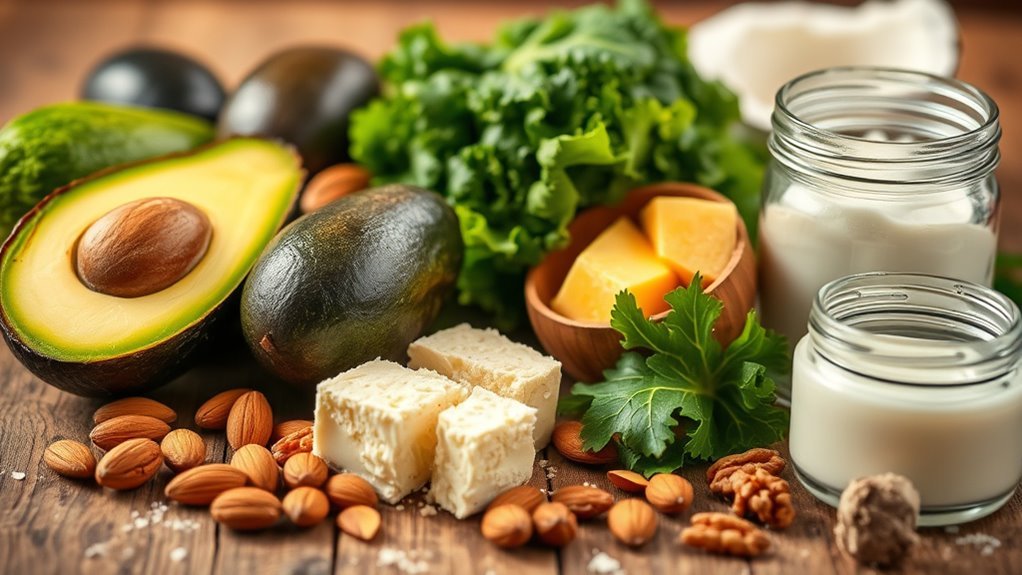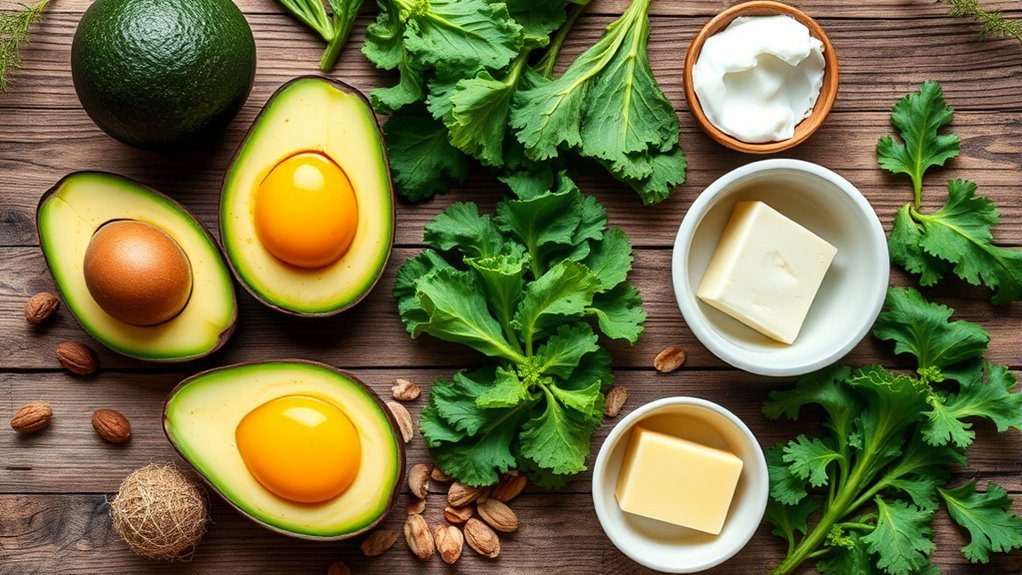Keto refers to a low-carbohydrate, high-fat diet that shifts your body’s metabolism into ketosis, where fat becomes your primary energy source instead of glucose. This dietary approach typically limits your daily carb intake to about 20-50 grams while promoting moderate protein consumption and high fat intake. It’s important to understand key components and potential benefits, as well as drawbacks. You’ll find plenty of information on how to successfully change into and thrive on a keto lifestyle.
Understanding Ketosis: The Science Behind Keto

When you think about the ketogenic diet, it’s essential to understand ketosis, the metabolic state that makes it effective for many people. During the ketosis process, your body shifts from using glucose as its primary fuel source to burning fat for energy production. This fat adaptation can lead to improved body composition and favorable changes in health markers. As glucose levels drop, your body undergoes digestive changes, optimizing how it processes nutrients. Additionally, hormonal balance is vital during ketosis, as it influences hunger and metabolism. Many individuals also report enhanced mental clarity, a benefit that stems from using ketones, a byproduct of fat metabolism, as an alternative energy source for the brain. Understanding these aspects can empower your keto journey.
Key Components of a Keto Diet

When you consider a keto diet, you’ll find three key components that define it: low carbohydrate intake, high fat consumption, and moderate protein levels. By reducing carbs considerably, your body shifts into a state of ketosis, relying on fat for energy instead. Understanding how these elements work together is essential for successfully implementing a keto lifestyle.
Low Carbohydrate Intake
One of the fundamental aspects of a ketogenic diet is its emphasis on low carbohydrate intake, which typically limits daily carbs to around 20 to 50 grams. This restriction helps your body enter a state of ketosis, where it burns fat for fuel instead of glucose. Engaging in carb cycling can also be beneficial, allowing you to strategically adjust your carbohydrate intake for energy needs. Monitoring your glucose levels is crucial to guarantee you remain in ketosis while optimizing your diet.
| Food Type | Carbohydrate Content (grams) | Notes |
|---|---|---|
| Leafy Greens | 1-3 | Low in carbs, nutrient-dense |
| Nuts and Seeds | 5-6 | Good fats, moderate carbs |
| Berries | 10-15 | Higher in carbs, consume in moderation |
High Fat Consumption
High fat consumption is a cornerstone of the ketogenic diet, as it provides the primary source of energy when carbohydrates are greatly restricted. To effectively embrace high fat intake, consider the following:
- Fat Sources: Focus on healthy oils, avocados, and nuts for essential dietary fats.
- Keto Fats: Incorporate high-quality fats like MCT oil and grass-fed butter to enhance fat adaptation.
- Cooking Methods: Use techniques such as sautéing or baking with keto-friendly fats to optimize flavor and nutrition.
- Meal Planning: Strategically plan meals and snack options around various fat types, ensuring a diverse intake.
Moderate Protein Levels
Moderate protein levels are crucial in a ketogenic diet, as they help to maintain muscle mass while still allowing the body to enter and remain in a state of ketosis. Consuming the right amount of protein guarantees you achieve a protein balance that supports your energy needs without exceeding carbohydrate limits. Ideal protein sources include lean meats, fish, eggs, and plant-based options like tofu and tempeh. Too much protein can lead to gluconeogenesis, where excess protein converts to glucose, potentially disrupting ketosis. Consequently, focusing on moderate intake helps you enjoy the freedom of varied food choices while staying aligned with your keto goals. Pay attention to your body’s needs and adjust your protein sources accordingly for best results.
Health Benefits of Going Keto

As you explore the health benefits of going keto, you may find that this low-carbohydrate, high-fat diet can lead to significant improvements in your overall well-being. Here are some key benefits you might experience:
- Keto Weight Loss: Many people report quicker fat loss due to reduced insulin levels and increased fat burning.
- Keto Mental Clarity: The ketogenic diet can enhance cognitive function, leading to sharper focus and better memory.
- Reduced Cravings: By stabilizing blood sugar levels, you’ll likely experience fewer hunger pangs and cravings.
- Increased Energy Levels: Once your body adapts to burning fat for fuel, you may notice sustained energy throughout the day.
These benefits can empower you to take control of your health and lifestyle.
Potential Drawbacks and Considerations
While the keto diet can offer health benefits, it’s important to contemplate potential drawbacks. You might face nutritional deficiencies due to restricted food groups, and long-term sustainability could be challenging for many. Evaluating these factors can help you make an informed decision about whether keto is right for you.
Nutritional Deficiencies Risks
Although the ketogenic diet can offer various health benefits, it also poses significant risks for nutritional deficiencies that individuals should consider. Maintaining a proper nutrient balance is essential, as the diet’s restrictive nature may lead to:
- Vitamin Deficiencies: Limited food variety can result in inadequate intake of essential vitamins.
- Mineral Intake: Low carbohydrate consumption may affect your body’s mineral management, particularly sodium and potassium.
- Fiber Sources: The reduction of fruits and whole grains can lead to insufficient fiber, impacting digestive health.
- Hydration Strategies: Proper hydration and electrolyte management are critical, as keto can cause increased fluid loss.
To mitigate these risks, consider supplementation needs and monitor your health closely. Prioritizing diverse food sourcing can help maintain overall wellness.
Long-term Sustainability Issues
Many people find the ketogenic diet appealing for its potential weight loss benefits, but its long-term sustainability raises important concerns. One significant issue is the challenge of long-term adherence. Many individuals struggle to maintain the strict macronutrient ratios required, leading to potential diet fatigue. Additionally, some may experience social isolation during events where keto-friendly options are limited. Nutritional deficiencies can arise if the diet isn’t properly managed over time, impacting overall health. In addition, the long-term effects of a high-fat diet remain under research. If you’re considering keto sustainability, it’s essential to weigh these factors carefully and consider whether this restrictive approach aligns with your lifestyle and personal health goals. Balance and moderation are key to lasting success.
Foods to Include and Avoid on Keto
Understanding which foods to include and avoid on a keto diet is essential for achieving its intended effects, as this low-carb, high-fat approach can greatly alter your body’s metabolism. Proper meal planning helps you stay on track with your goals. Here’s a quick list:
- Include: Avocados – High in healthy fats.
- Include: Eggs – A great source of protein and fats.
- Avoid: Bread – High in carbs, which you’ll want to limit.
- Avoid: Sugary snacks – These can derail your progress.
For keto snacks, focus on cheese, nuts, and low-carb veggies. Making informed food choices will empower you and enhance your keto journey, giving you the freedom to enjoy delicious meals while achieving your health goals.
How to Transition to a Keto Lifestyle
Wondering how to smoothly shift to a keto lifestyle? Start by embracing meal prep to guarantee you have keto-friendly options readily available. Focus on grocery shopping with a keen eye on food labels, identifying low-carb ingredients. Mindset shifts are essential; think about how you can adapt family meals and dining out experiences to fit your new lifestyle.
| Grocery Shopping | Snack Options |
|---|---|
| Avocados | Nuts |
| Leafy greens | Cheese sticks |
| Cauliflower | Hard-boiled eggs |
Explore recipe ideas that excite you, and don’t hesitate to communicate your choices in social situations. Shifting to keto can empower your culinary freedom while keeping your taste buds satisfied!
Common Misconceptions About Keto
While you might think keto is just another fad diet, it’s essential to separate fact from fiction to fully grasp its principles. Here are some common keto myths and dietary misconceptions you should be aware of:
- Keto is all bacon and cheese: It’s about healthy fats, not just processed foods.
- You can’t eat vegetables: Non-starchy veggies are encouraged and nutritious.
- Keto leads to nutrient deficiencies: With proper planning, you can meet your nutritional needs.
- You’ll regain weight immediately after stopping: Sustainable habits can prevent weight regain.
Understanding these misconceptions can empower you to make informed choices on your keto journey, ensuring you reap the benefits of this lifestyle while avoiding potential pitfalls.
Tips for Success on Your Keto Journey
To achieve success on your keto journey, it is crucial to have a clear plan and set realistic goals. Start with meal planning; prepare keto-friendly meals that include healthy fats, proteins, and low-carb vegetables. This not only simplifies your choices but also helps you stay on track.
In social situations, develop strategies that allow you to enjoy gatherings without compromising your diet. Communicate your dietary preferences to friends and family, or offer to bring a keto dish to share.
Track your progress to stay motivated, and don’t hesitate to adjust your approach if needed. Remember, consistency is key, so embrace flexibility and listen to your body. With the right mindset and strategies, you can successfully navigate your keto lifestyle.


